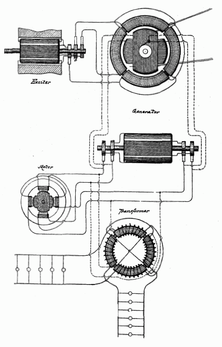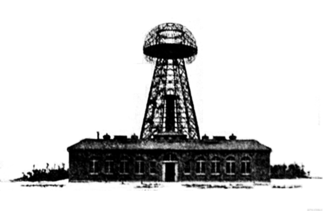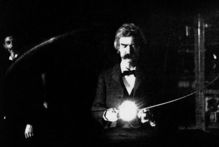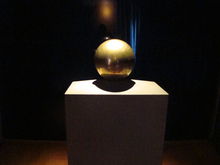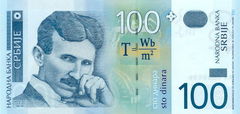Nikola Tesla (Serbian: Никола Тесла; 10 July 1856 – 7 January 1943) was an inventor, mechanical engineer, and electrical engineer. He was an important contributor to the birth of commercial electricity, and is best known for his many revolutionary developments in the field of electromagnetism in the late 19th and early 20th centuries. Tesla's patents and theoretical work formed the basis of modern alternating current (AC) electric power systems, including the polyphase system of electrical distribution and the AC motor. This work helped usher in the Second Industrial Revolution.
Born an ethnic Serb in the village of Smiljan, then part of the Croatian Military Frontier of the Austrian Empire (modern-day Croatia). Tesla was a subject of the Austrian Empire by birth and later became an American citizen.[1] Because of his 1894 demonstration of wireless communication through radio and as the eventual victor in the "War of Currents", he was widely respected as one of the greatest electrical engineers who worked in America.[2] He pioneered modern electrical engineering and many of his discoveries were of groundbreaking importance. In the United States during this time, Tesla's fame rivaled that of any other inventor or scientist in history or popular culture.[3] Tesla demonstrated wireless energy transfer to power electronic devices as early as 1893, and aspired to intercontinental wireless transmission of industrial power in his unfinished Wardenclyffe Tower project.
Because of his eccentric personality and his seemingly unbelievable and sometimes bizarre claims about possible scientific and technological developments, Tesla was ultimately ostracized and regarded as a mad scientist by many late in his life.[4] Tesla never put much focus on his finances and died with little funds at the age of 86, alone in the two room hotel suite in which he lived, in New York City.[5]
The International System of Units unit measuring magnetic field B (also referred to as the magnetic flux density and magnetic induction), the tesla, was named in his honor (at the Conférence Générale des Poids et Mesures, Paris, 1960).
In addition to his work on electromagnetism and electromechanical engineering, Tesla contributed in varying degrees to the establishment of robotics, remote control, radar, and computer science, and to the expansion of ballistics, nuclear physics, and theoretical physics.
Early years
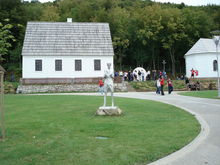

Nikola Tesla's birth house and statue in the village of
Smiljan,
Croatia 

c.1879 at age 23
Tesla was born to Serbian parents in the village of Smiljan, Austrian Empire near the town of Gospić, in the territory of modern-day Croatia. His baptismal certificate reports that he was born on 28 June (N.S. 10 July), 1856, to Father Milutin Tesla, a priest in the Serbian Orthodox Church.[6] His paternal origin is thought to be either of one of the local Serb clans in the Tara valley or from the Herzegovinian noble Pavle Orlović.[7] His mother, Đuka, daughter of a Serbian Orthodox Church priest, came from a family domiciled in Lika and Banija, but with deeper origins to Kosovo. She was talented in making home craft tools and memorized many Serbian epic poems, but never learned to read.[8]
Nikola was the fourth of five children, having one older brother (Dane, who was killed in a horse-riding accident when Nikola was five) and three sisters (Milka, Angelina and Marica).[9] His family moved to Gospić in 1862. Tesla attended school at Higher Real Gymnasium in Karlovac.[10] He finished a four-year term in the span of three years.[11]
Tesla went on to study electrical engineering at the Austrian Polytechnic in Graz (1875). While there, he studied the uses of alternating current. Some sources say he received Baccalaureate degrees from the university at Graz.[12][13][14] However, the university says that he did not receive a degree and did not continue beyond the first semester of his third year, during which he stopped attending lectures.[15][16][17][18] In December 1878, Tesla left Graz and broke all relations with his family. His friends thought that he had drowned in the Mura River. He went to Marburg, (today's Maribor, in Slovenia), where he was first employed as an assistant engineer for a year. He suffered a nervous breakdown during this time. Tesla was later persuaded by his father to attend the Charles-Ferdinand University in Prague, which he attended for the summer term of 1880. Here, he was influenced by Ernst Mach. However, after his father died, he left the university, having completed only one term.[19]
Tesla engaged in reading many works, memorizing complete books, supposedly having a photographic memory.[20] Tesla related in his autobiography that he experienced detailed moments of inspiration. During his early life, Tesla was stricken with illness time and time again. He suffered a peculiar affliction in which blinding flashes of light would appear before his eyes, often accompanied by visions. Much of the time the visions were linked to a word or idea he might have come across, at other times they would provide the solution to a particular problem he had been encountering; just by hearing the name of an item, he would be able to envision it in realistic detail. Modern-day synesthetes report similar symptoms. Tesla would visualize an invention in his mind with extreme precision, including all dimensions, before moving to the construction stage; a technique sometimes known as picture thinking. He typically did not make drawings by hand, instead just conceiving all ideas with his mind. Tesla also often had flashbacks to events that had happened previously in his life; these began during his childhood.[20]
In 1880, he moved to Budapest to work under Tivadar Puskás in a telegraph company,[21] the National Telephone Company. There, he met Nebojša Petrović, a young, Serbian inventor who lived in Austria. Although their encounter was brief, they did work on a project together using twin turbines to create continual power. On the opening of the telephone exchange in Budapest, 1881, Tesla became the chief electrician to the company, and was later engineer for the country's first telephone system. He also developed a device that, according to some, was a telephone repeater or amplifier, but according to others could have been the first loudspeaker.[22]


Drawing from U.S.
Patent 381968, illustrating principle of alternating current motor invention
France and the United States
In 1882 he moved to Paris, to work as an engineer for the Continental Edison Company, designing improvements to electric equipment brought overseas from Edison's ideas. According to his autobiography, in the same year he conceived the induction motor and began developing various devices that use rotating magnetic fields for which he received patents in 1888.
Soon thereafter, Tesla was awakened from a dream in which his mother had died.[23] After her death, Tesla fell ill. He spent two to three weeks recuperating in Gospić and the village of Tomingaj near Gračac, his mother's birthplace.
On 6 June 1884, Tesla first arrived in the United States, in New York City[24] with little besides a letter of recommendation from Charles Batchelor, a former employer. In the letter of recommendation to Thomas Edison, it is claimed that Batchelor wrote, 'I know two great men and you are one of them; the other is this young man', but the exact contents of the letter is disputed in McNichol's book. Edison hired Tesla to work for his Edison Machine Works. Tesla's work for Edison began with simple electrical engineering and quickly progressed to solving some of the company's most difficult problems. Tesla was even offered the task of completely redesigning the Edison company's direct current generators.[25]
Tesla claimed he was offered US$50,000 (~ US$1.1 million in 2007, adjusted for inflation)[26] if he redesigned Edison's inefficient motor and generators, making an improvement in both service and economy.[27] In 1885 when Tesla inquired about the payment for his work, Edison replied, "Tesla, you don't understand our American humor," thus breaking his word.[28][29] Earning US$18 per week, Tesla would have had to work for 53 years to earn the amount he was promised. The offer was equal to the initial capital of the company. Tesla immediately resigned when he was refused a raise to US$25 per week.[30]
Tesla, in need of work, eventually found himself digging ditches for a short period of time for the Edison company. He used this time to focus on his AC polyphase system.[31]
Middle years
Electromechanical devices and principles developed by Nikola Tesla:
|
In 1886, Tesla formed his own company, Tesla Electric Light & Manufacturing. The initial financial investors disagreed with Tesla on his plan for an alternating current motor and eventually relieved him of his duties at the company. Tesla worked in New York as a laborer from 1886 to 1887 to feed himself and raise capital for his next project. In 1887, he constructed the initial brushless alternating current induction motor, which he demonstrated to the American Institute of Electrical Engineers (now IEEE) in 1888. In the same year, he developed the principles of his Tesla coil, and began working with George Westinghouse at Westinghouse Electric & Manufacturing Company's Pittsburgh labs. Westinghouse listened to his ideas for polyphase systems which would allow transmission of alternating current electricity over long distances.
In April 1887, Tesla began investigating what would later be called X-rays using his own single terminal vacuum tubes (similar to his patent #514,170). This device differed from other early X-ray tubes in that it had no target electrode. The modern term for the phenomenon produced by this device is bremsstrahlung (or braking radiation). We now know that this device operated by emitting electrons from the single electrode through a combination of field electron emission and thermionic emission. Once liberated, electrons are strongly repelled by the high electric field near the electrode during negative voltage peaks from the oscillating HV output of the Tesla Coil, generating X rays as they collide with the glass envelope. He also used Geissler tubes. By 1892, Tesla became aware of the skin damage that Wilhelm Röntgen later identified as an effect of X rays.
In the early research, Tesla devised several experimental setups to produce X-rays. Tesla held that, with his circuits, the "instrument will [... enable one to] generate Roentgen rays of much greater power than obtainable with ordinary apparatus".[47]
He also commented on the hazards of working with his circuit and single-node X-ray-producing devices. Of his many notes in the early investigation of this phenomenon, he attributed the skin damage to various causes. He believed early on that damage to the skin was not caused by the Roentgen rays, but the ozone generated in contact with the skin, and to a lesser extent, nitrous acid. Tesla incorrectly held that x-rays were longitudinal waves, such as those produced in waves in plasma. There are known examples of this and these plasma waves can occur in the situation of force-free magnetic fields.[48][49] His hypotheses and experiments were confirmed by others.[50]
Tesla continued research in the field. He performed several experiments prior to Roentgen's discovery (including photographing the bones of his hand; later, he sent these images to Roentgen) but did not make his findings widely known; much of his research was lost in the 5th Avenue laboratory fire of March 1895.
The Tesla generator was developed by Tesla in 1895, in conjunction with his developments concerning the liquefaction of air. Tesla knew, from Lord Kelvin's discoveries, that more heat is absorbed by liquefied air when it is re-gasified and used to drive something, than is required by theory; in other words, that the liquefaction process is somewhat anomalous or 'over unity'.[51] Just prior to Tesla's completion of his work and the filing of a patent application, Tesla's laboratory burned down, destroying all his equipment, models and inventions. Immediately after the fire, Carl von Linde, in Germany, filed a patent application for the same process.[52]
A "world system" for "the transmission of electrical energy without wires" that depends upon the electrical conductivity of the earth was proposed, in which transmission in various natural media with current that passes between the two points are used to power devices. In a practical wireless energy transmission system using this principle, a high-power ultraviolet beam might be used to form a vertical ionized channel in the air directly above the transmitter-receiver stations. The same concept is used in virtual lightning rods, the electrolaser electroshock weapon,[53] and has been proposed for disabling vehicles.
Tesla demonstrated wireless energy transmission as early as 1891. The Tesla effect is a term for an application of this type of electrical conduction (that is, the movement of energy through space and matter, not just the production of voltage across a conductor).[54][55]
American citizenship
On 30 July 1891, he became a naturalized citizen of the United States at the age of 35. Tesla established his South Fifth Avenue laboratory in New York in the same year. Later, Tesla established his Houston Street laboratory in New York at 46 E. Houston Street. He lit electric lamps wirelessly at both of the New York locations, providing evidence for the potential of wireless power transmission.[56]
Some of Tesla's closest friends were artists. He befriended Century Magazine editor Robert Underwood Johnson, who adapted several Serbian poems of Jovan Jovanović Zmaj (which Tesla translated). Also during this time, Tesla was influenced by the Vedic philosophy (i.e., Hinduism) teachings of the Swami Vivekananda; so much so that, after his exposure to Hindu-Vedic thought, Tesla started using Sanskrit words to name some of his fundamental concepts regarding matter and energy.[57]
When Tesla was 36 years old, the first patents concerning the polyphase power system were granted. He continued research of the system and rotating magnetic field principles. Tesla served, from 1892 to 1894, as the vice president of the American Institute of Electrical Engineers, the forerunner (along with the Institute of Radio Engineers) of the modern-day IEEE. From 1893 to 1895, he investigated high frequency alternating currents. He generated AC of one million volts using a conical Tesla coil and investigated the skin effect in conductors, designed tuned circuits, invented a machine for inducing sleep, cordless gas discharge lamps, and transmitted electromagnetic energy without wires, building the first radio transmitter. In St. Louis, Missouri, Tesla made a demonstration related to radio communication in 1893. Addressing the Franklin Institute in Philadelphia, Pennsylvania and the National Electric Light Association, he described and demonstrated in detail its principles. Tesla's demonstrations were written about widely through various media outlets. Tesla also investigated harvesting energy that is present throughout space. He believed that it was merely a question of time when men would succeed in attaching their machinery to the very wheelwork of nature, stating: "Ere many generations pass, our machinery will be driven by a power obtainable at any point of the universe."[58]
At the 1893 World's Fair, the World's Columbian Exposition in Chicago, an international exposition was held which, for the first time, devoted a building to electrical exhibits. It was a historic event as Tesla and George Westinghouse introduced visitors to AC power by using it to illuminate the Exposition. On display were Tesla's fluorescent lamps and single node bulbs. An observer noted:
Within the room was suspended two hard-rubber plates covered with tin foil. These were about fifteen feet apart, and served as terminals of the wires leading from the transformers. When the current was turned on, the lamps or tubes, which had no wires connected to them, but lay on a table between the suspended plates, or which might be held in the hand in almost any part of the room, were made luminous. These were the same experiments and the same apparatus shown by Tesla in London about two years previous, "where they produced so much wonder and astonishment".
[59]
Tesla also explained the principles of the rotating magnetic field and induction motor by demonstrating how to make an egg made of copper stand on end in his demonstration of the device he constructed known as the "Egg of Columbus".
Edison
Also in the late 1880s, Tesla and Thomas Edison became adversaries in part because of Edison's promotion of direct current (DC) for electric power distribution over the more efficient alternating current advocated by Tesla and Westinghouse. Until Tesla invented the induction motor, AC's advantages for long distance high voltage transmission were counterbalanced by the inability to operate motors on AC. As a result of the "War of Currents", Edison and Westinghouse went nearly bankrupt, so in 1897, Tesla released Westinghouse from contract, providing Westinghouse a break from Tesla's patent royalties. Also in 1897, Tesla researched radiation, which led to setting up the basic formulation of cosmic rays.[60]
When Tesla was 41 years old, he filed the first radio patent (U.S. Patent 645,576). A year later, he demonstrated a radio-controlled boat to the US military, believing that the military would want things such as radio-controlled torpedoes. Tesla claimed to have developed the "Art of Telautomatics", a form of robotics, as well as the technology of remote control.[61] In 1898, he demonstrated a radio-controlled boat to the public during an electrical exhibition at Madison Square Garden. Tesla called his boat a "teleautomaton".[62] In the same year, Tesla devised an "electric igniter" or spark plug for Internal combustion gasoline engines. He gained U.S. Patent 609,250, "Electrical Igniter for Gas Engines", on this mechanical ignition system. Tesla lived in the former Gerlach Hotel, renamed The Radio Wave building, at 49 W 27th St. (between Broadway and Sixth Avenue), Lower Manhattan, before the end of the century where he conducted the radio wave experiments. A commemorative plaque was placed on the building in 1977 to honor his work. Remote radio control remained a novelty until WWI and afterward, when a number of countries used it in military programs.
Colorado Springs
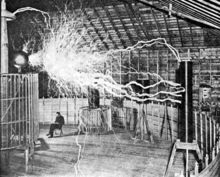

Publicity picture of a participant sitting in his laboratory in Colorado Springs with his "
Magnifying transmitter" generating millions of volts. The arcs are about 7 meters (23 ft) long. (Tesla's notes identify this as a
multiple exposure photograph.)
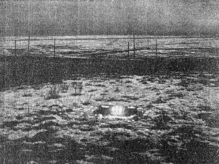

An experiment in Colorado Springs. This bank of lights is receiving power by means of electrodynamic induction from a nearby transmitter


A Colorado Springs experiment: here a grounded tuned coil in
resonance with a distant transmitter illuminates a light near the bottom of the picture.
In 1899, Tesla decided to move and began research in Colorado Springs, Colorado in a lab located near Foote Ave. and Kiowa St.,[63] where he would have room for his high-voltage, high-frequency experiments. Upon his arrival he told reporters that he was conducting wireless telegraphy experiments transmitting signals from Pikes Peak to Paris. Tesla's diary contains explanations of his experiments concerning the ionosphere and the ground's telluric currents via transverse waves and longitudinal waves.[64] At his lab, Tesla proved that the earth was a conductor, and he produced artificial lightning (with discharges consisting of millions of volts, and up to 135 feet long).[65] Tesla also investigated atmospheric electricity, observing lightning signals via his receivers. Reproductions of Tesla's receivers and coherer circuits show an unpredicted level of complexity (e.g., distributed high-Q helical resonators, radio frequency feedback, crude heterodyne effects, and regeneration techniques).[66] Tesla stated that he observed stationary waves during this time.[67]
Tesla researched ways to transmit power and energy wirelessly over long distances (via transverse waves, to a lesser extent, and, more readily, longitudinal waves). He transmitted extremely low frequencies through the ground as well as between the Earth's surface and the Kennelly–Heaviside layer. He received patents on wireless transceivers that developed standing waves by this method. In his experiments, he made mathematical calculations and computations based on his experiments and discovered that the resonant frequency of the Earth was approximately 8 hertz (Hz). In the 1950s, researchers confirmed that the resonant frequency of the Earth's ionospheric cavity was in this range (later named the Schumann resonance).
In Colorado Springs Tesla carried out various long distance wireless transmission-reception experiments. Tesla effect is the application of a type of electrical conduction (that is, the movement of energy through space and matter; not just the production of voltage across a conductor). Through longitudinal waves, Tesla transferred energy to receiving devices. He sent electrostatic forces through natural media across a conductor situated in the changing magnetic flux and transferred electrical energy to a wireless receiver.
In the Colorado Springs lab, Tesla observed unusual signals that he later thought may have been evidence of extraterrestrial radio wave communications coming from Venus or Mars.[68] He noticed repetitive signals from his receiver which were substantially different from the signals he had noted from storms and earth noise. Specifically, he later recalled that the signals appeared in groups of one, two, three, and four clicks together. Tesla had mentioned that he thought his inventions could be used to talk with other planets. There have even been claims that he invented a "Teslascope" for just such a purpose. It is debatable what type of signals Tesla received or whether he picked up anything at all. Research has suggested that Tesla may have had a misunderstanding of the new technology he was working with,[69] or that the signals Tesla observed may have been non-terrestrial natural radio source such as the Jovian plasma torus signals.[70]
Tesla left Colorado Springs on 7 January 1900. The lab was torn down ca. 1905 and its contents sold to pay debts. The Colorado experiments prepared Tesla for the establishment of the trans-Atlantic wireless telecommunications facility known as Wardenclyffe.
Wardenclyffe years
In 1900, with US$150,000 (51% from J. Pierpont Morgan), Tesla began planning the Wardenclyffe Tower facility. In June 1902, Tesla's lab operations were moved to Wardenclyffe from Houston Street. The tower was dismantled for scrap during World War I.[71] Newspapers of the time labeled Wardenclyffe "Tesla's million-dollar folly". In 1904, the US Patent Office reversed its decision and awarded Guglielmo Marconi the patent for radio, and Tesla began his fight to re-acquire the radio patent. On his 50th birthday in 1906, Tesla demonstrated his 200 hp (150 kW) 16,000 rpm bladeless turbine. During 1910–1911 at the Waterside Power Station in New York, several of his bladeless turbine engines were tested at 100–5000 hp.
Nobel prize and Tesla
Since the Nobel Prize in Physics was awarded to Marconi for radio in 1909, Thomas Edison and Tesla were mentioned in a press dispatch as potential laureates to share the Nobel Prize of 1915, leading to one of several Nobel Prize controversies. Some sources have claimed that because of their animosity toward each other neither was given the award, despite their scientific contributions; that each sought to minimize the other's achievements and right to win the award; that both refused to ever accept the award if the other received it first; and that both rejected any possibility of sharing it.[8][72]
In the years after these rumors, neither Tesla nor Edison won the Prize (although Edison did receive one of 38 possible bids in 1915, and Tesla did receive one bid out of 38 in 1937).[73] Earlier, Tesla alone was rumored to have been nominated for the Nobel Prize of 1912. The rumored nomination was primarily for his experiments with tuned circuits using high-voltage high-frequency resonant transformers.
Later years
In 1915, Tesla filed a lawsuit against Marconi attempting, unsuccessfully, to obtain a court injunction against Marconi's claims. After Wardenclyffe, Tesla built the Telefunken Wireless Station in Sayville, Long Island. Some of what he wanted to achieve at Wardenclyffe was accomplished with the Telefunken Wireless. In 1917, the facility was seized and torn down by the Marines, because it was suspected that it could be used by German spies.
Before World War I, Tesla looked overseas for investors to fund his research. When the war started, Tesla lost the funding he was receiving from his patents in European countries. After the war ended, Tesla made predictions regarding the relevant issues of the post-World War I environment, in a printed article (20 December 1914). Tesla believed that the League of Nations was not a remedy for the times and issues. Tesla started to exhibit pronounced symptoms of obsessive-compulsive disorder in the years following. He became obsessed with the number three; he often felt compelled to walk around a block three times before entering a building, demanded a stack of three folded cloth napkins beside his plate at every meal, etc. The nature of OCD was little understood at the time and no treatments were available, so his symptoms were considered by some to be evidence of partial insanity, and this undoubtedly hurt what was left of his reputation.
At this time, he was staying at The Waldorf-Astoria Hotel, renting in an arrangement for deferred payments. Eventually, the Wardenclyffe deed was turned over to George Boldt, proprietor of the Waldorf-Astoria, to pay a US$20,000 debt. In 1917, around the time that the Wardenclyffe Tower was demolished by Boldt to make the land a more viable real estate asset, Tesla received AIEE's highest honor, the Edison Medal.
Tesla, in August 1917, first established principles regarding frequency and power level for the first primitive radar units.[74]
In 1934, Émile Girardeau, working with the first French radar systems, stated he was building them "according to the principles stated by Tesla". By the 1920s, Tesla was reportedly negotiating with the United Kingdom government about a ray system. Tesla had also stated that efforts had been made to steal the so called "death ray". It is suggested that the removal of the Chamberlain government ended negotiations.
On Tesla's 75th birthday in 1931, Time magazine put him on its cover. The cover caption noted his contribution to electrical power generation. Tesla received his last patent in 1928 for an apparatus for aerial transportation which was the first instance of VTOL aircraft. By the end of 1931, Tesla released "On Future Motive Power" which covered an ocean thermal energy conversion system. In 1934, Tesla wrote to consul Janković of his homeland. The letter contained a message of gratitude to Mihajlo Pupin who had initiated a donation scheme by which American companies could support Tesla. Tesla refused the assistance, choosing instead to live on a modest pension received from Yugoslavia, and to continue his research.
In 1936, Tesla wrote in a telegram to Vladko Maček: "I'm equally proud of my Serbian origin and my Croatian homeland. Long live all Yugoslavs."
Field theories
When he was 81, Tesla stated he had completed a "dynamic theory of gravity". He stated that it was "worked out in all details" and that he hoped to soon give it to the world.[75] The theory was never published.
The bulk of the theory was developed between 1892 and 1894, during the period that he was conducting experiments with high frequency and high potential electromagnetism and patenting devices for their use. Reminiscent of Mach's principle, Tesla stated in 1925 that:


Nikola Tesla, with
Ruđer Bošković's book
Theoria Philosophiae Naturalis, sits in front of the spiral coil of his high-frequency transformer at East Houston Street, New York.
There is no thing endowed with life—from man, who is enslaving the elements, to the nimblest creature—in all this world that does not sway in its turn. Whenever action is born from force, though it be infinitesimal, the cosmic balance is upset and the universal motion results.
Tesla was critical of Einstein's relativity work, calling it:
...[a] magnificent mathematical garb which fascinates, dazzles and makes people blind to the underlying errors. The theory is like a beggar clothed in purple whom ignorant people take for a king ... its exponents are brilliant men but they are metaphysicists rather than scientists ...[76]
Tesla also argued:
I hold that space cannot be curved, for the simple reason that it can have no properties. It might as well be said that God has properties. He has not, but only attributes and these are of our own making. Of properties we can only speak when dealing with matter filling the space. To say that in the presence of large bodies space becomes curved is equivalent to stating that something can act upon nothing. I, for one, refuse to subscribe to such a view.[77]
Tesla also believed that much of Albert Einstein's relativity theory had already been proposed by Ruđer Bošković, stating in an unpublished interview:
...the relativity theory, by the way, is much older than its present proponents. It was advanced over 200 years ago by my illustrious countryman Ruđer Bošković, the great philosopher, who, not withstanding other and multifold obligations, wrote a thousand volumes of excellent literature on a vast variety of subjects. Bošković dealt with relativity, including the so-called time-space continuum ...'.[78]
Directed-energy weapon
Later in life, Tesla made remarkable claims concerning a "teleforce" weapon.[79] The press called it a "peace ray" or death ray.[80][81] In total, the components and methods included:[82][83]
- An apparatus for producing manifestations of energy in free air instead of in a high vacuum as in the past. This, according to Tesla in 1934, was accomplished.
- A mechanism for generating tremendous electrical force. This, according to Tesla, was also accomplished.
- A means of intensifying and amplifying the force developed by the second mechanism.
- A new method for producing a tremendous electrical repelling force. This would be the projector, or gun, of the invention.
Tesla worked on plans for a directed-energy weapon from the early 1900s until his death. In 1937, Tesla wrote a treatise entitled "The Art of Projecting Concentrated Non-dispersive Energy through the Natural Media", which concerned charged particle beams.[84] Tesla published the document in an attempt to expound on the technical description of a "superweapon that would put an end to all war." This treatise describing the particle beam is currently in the Nikola Tesla Museum archive in Belgrade. It describes an open-ended vacuum tube with a gas jet seal that allows particles to exit, a method of charging particles to millions of volts, and a method of creating and directing nondispersive particle streams (through electrostatic repulsion).[84]
His records indicate that the device is based on a narrow stream of atomic clusters of liquid mercury or tungsten accelerated via high voltage (by means akin to his magnifying transformer). Tesla gives the following description concerning the particle gun's operation:
[The nozzle would] send concentrated beams of particles through the free air, of such tremendous energy that they will bring down a fleet of 10,000 enemy airplanes at a distance of 200 miles from a defending nation's border and will cause armies to drop dead in their tracks.[85]
The weapon could be used against ground based infantry or for antiaircraft purposes.[86] Tesla tried to interest the US War Department in the device.[87] He also offered this invention to European countries.[88] None of the governments purchased a contract to build the device. He was unable to act on his plans.[89]
Theoretical inventions
Another of Tesla's theorized inventions is commonly referred to as Tesla's Flying Machine, which appears to resemble an ion-propelled aircraft.[90] Tesla claimed that one of his life goals was to create a flying machine that would run without the use of an airplane engine, wings, ailerons, propellers, or an onboard fuel source. Initially, Tesla pondered about the idea of a flying craft that would fly using an electric motor powered by grounded base stations. As time progressed, Tesla suggested that perhaps such an aircraft could be run entirely electro-mechanically. The theorized appearance would typically take the form of a cigar or saucer.[91]
Personal life


Tesla's father Milutin Tesla
Tesla was fluent in eight languages. Along with Serbian, he spoke Czech, English, French, German, Hungarian, Italian, and Latin.[92]
Tesla may have suffered from obsessive-compulsive disorder, and had many unusual quirks and phobias. He did things in threes, and was adamant about staying in a hotel room with a number divisible by three. Tesla was physically revolted by jewelry, notably pearl earrings.[93] He was fastidious about cleanliness and hygiene, and was by all accounts mysophobic.
Tesla was obsessed with pigeons, ordering special seeds for the pigeons he fed in Central Park and even bringing injured ones into his hotel room to nurse them back to health. Tesla was an animal-lover, often reflecting contentedly about a childhood cat, "The Magnificent Mačak." Tesla never married. He was celibate and claimed that his chastity was very helpful to his scientific abilities.[20] Nonetheless there have been numerous accounts of women vying for Tesla's affection, even some madly in love with him. Tesla, though polite, behaved rather ambivalently to these women in the romantic sense.
Tesla was prone to alienating himself and was generally soft-spoken. However, when he did engage in a social life, many people spoke very positively and admiringly of him. Robert Underwood Johnson described him as attaining a "distinguished sweetness, sincerity, modesty, refinement, generosity, and force." His loyal secretary, Dorothy Skerrit, wrote: "his genial smile and nobility of bearing always denoted the gentlemanly characteristics that were so ingrained in his soul." Tesla's friend Hawthorne wrote that "seldom did one meet a scientist or engineer who was also a poet, a philosopher, an appreciator of fine music, a linguist, and a connoisseur of food and drink."
Nevertheless, Tesla displayed the occasional cruel streak; he openly expressed his disgust for overweight people, once firing a secretary because of her weight.[94] He was quick to criticize others' clothing as well, on several occasions directing a subordinate to go home and change her dress.[20]
Tesla was widely known for his great showmanship, presenting his innovations and demonstrations to the public as an artform, almost like a magician. This seems to conflict with his observed reclusiveness; Tesla was a complicated figure. He refused to hold conventions without his Tesla coil blasting electricity throughout the room, despite the audience often being terrified, though he assured them everything was perfectly safe.
In middle age, Tesla became close friends with Mark Twain. They spent a lot of time together in his lab and elsewhere.
Tesla remained bitter in the aftermath of his dispute with Edison. The day after Edison died the New York Times contained extensive coverage of Edison's life, with the only negative opinion coming from Tesla, who was quoted as saying:
He had no hobby, cared for no sort of amusement of any kind and lived in utter disregard of the most elementary rules of hygiene ... His method was inefficient in the extreme, for an immense ground had to be covered to get anything at all unless blind chance intervened and, at first, I was almost a sorry witness of his doings, knowing that just a little theory and calculation would have saved him 90 percent of the labor. But he had a veritable contempt for book learning and mathematical knowledge, trusting himself entirely to his inventor's instinct and practical American sense.
[95]
Shortly before he died, Edison said that his biggest mistake had been in trying to develop direct current, rather than the superior alternating current system that Tesla had put within his grasp.[96]
Tesla was good friends with Robert Underwood Johnson. He had amicable relations with Francis Marion Crawford, Stanford White, Fritz Lowenstein, George Scherff, and Kenneth Swezey. He ripped up a Westinghouse contract that would have made him the world's first billionaire, in part because of the implications it would have on his future vision of free power, and in part because it would run Westinghouse out of business, and Tesla had no desire to deal with the creditors.
Tesla lived the last ten years of his life in a two-room suite on the 33rd floor of the Hotel New Yorker, room 3327. There, near the end of his life, Tesla showed signs of encroaching senility, claiming to be visited by a specific white pigeon daily. Several biographers note that Tesla viewed the death of the pigeon as a "final blow" to himself and his work.
Tesla believed that war could not be avoided until the cause for its recurrence was removed, but was opposed to wars in general. However, Tesla came to find exceptions in which he thought certain situations and wars were justifiable.[97] Tesla sought to reduce distance, such as in communication for better understanding, transportation, and transmission of energy, as a means to ensure friendly international relations.[98]
Tesla was a life-long bachelor. Like many of his era, he became a proponent of a self-imposed selective breeding version of eugenics. In a 1937 interview, he stated:
... man's new sense of pity began to interfere with the ruthless workings of nature. The only method compatible with our notions of civilization and the race is to prevent the breeding of the unfit by sterilization and the deliberate guidance of the mating instinct .... The trend of opinion among eugenists is that we must make marriage more difficult. Certainly no one who is not a desirable parent should be permitted to produce progeny. A century from now it will no more occur to a normal person to mate with a person eugenically unfit than to marry a habitual criminal.
[99]
In 1926, Tesla commented on the ills of the social subservience of women and the struggle of women toward gender equality, indicated that humanity's future would be run by "Queen Bees". He believed that women would become the dominant sex in the future.[100]
In his later years Tesla became a vegetarian. In an article for Century Illustrated Magazine he wrote: "It is certainly preferable to raise vegetables, and I think, therefore, that vegetarianism is a commendable departure from the established barbarous habit." Tesla argued that it is wrong to eat uneconomic meat when large numbers of people are starving; he also believed that plant food was "superior to [meat] in regard to both mechanical and mental performance". He also argued that animal slaughter was "wanton and cruel".[101]
In his final years he suffered from extreme sensitivity to light, sound and other influences.[102]
Death
Tesla died of heart failure alone in room 3327 of the New Yorker Hotel, on 7 January 1943.[103] Despite having sold his AC electricity patents, Tesla died with significant debts. Later that year the US Supreme Court upheld Tesla's patent number 645576 in a ruling that served as the basis for patented radio technology in the United States.[104]
Tesla's funeral took place on 12 January 1943, at the Cathedral of Saint John the Divine in Manhattan, New York City.[105] His body was cremated and his ashes taken to Belgrade, Serbia, then-Yugoslavia in 1957. The urn was placed in the Nikola Tesla Museum in Belgrade.


Bust of Tesla by Ivan Meštrović, 1952, in
Zagreb, Croatia
Soon after his death Tesla's safe was opened by his nephew Sava Kosanović. Shortly thereafter Tesla's papers and other property were impounded by the United States' Alien Property Custodian office in Tesla's compound at the Manhattan Warehouse, even though he was a naturalized citizen.
Dr. John G. Trump was the main government official who went over Tesla's secret papers after his death in 1943. At the time, Trump was a well-known electrical engineer serving as a technical aide to the National Defense Research Committee of the Office of Scientific Research & Development, Technical Aids, Div. 14, NTRC (predecessor agency to the CIA's Office of Scientific Intelligence). Trump was also a professor at M.I.T., and had his feelings hurt by Tesla's 1938 review and critique of M.I.T.'s huge Van de Graaff generator with its two thirty-foot towers and two 15-foot-diameter (4.6 m) balls, mounted on railroad tracks—which Tesla showed could be out-performed in both voltage and current by one of his tiny coils about two feet tall.[106] Trump was asked to participate in the examination of Tesla's papers at the Manhattan Warehouse & Storage Co. Trump reported afterwards that no examination had been made of the vast amount of Tesla's property, that had been in the basement of the New Yorker Hotel, ten years prior to Tesla's death, or of any of his papers, except those in his immediate possession at the time of his death. Trump concluded in his report, that there was nothing that would constitute a hazard in unfriendly hands.
At the time of his death, Tesla had been working on the Teleforce weapon, or 'death ray,' that he had unsuccessfully marketed to the US War Department. It appears that Teleforce was related to his research into ball lightning and plasma, and was conceived as a particle beam weapon. The US government did not find a prototype of the device in the safe.
After the FBI was contacted by the War Department, his papers were declared to be top secret. The personal effects were sequestered on the advice of presidential advisers; J. Edgar Hoover declared the case most secret, because of the nature of Tesla's inventions and patents.[107] One document stated that "[he] is reported to have some 80 trunks in different places containing transcripts and plans having to do with his experiments [...]". Altogether, in Tesla's effects, there were the contents of his safe, two truckloads of papers and apparati from his hotel, another 75 packing crates and trunks in a storage facility, and another 80 large storage trunks in another storage facility. The Navy and several "federal officials" spent two days microfilming some of the stuff at the Office of Alien Properties storage facility in 1943, and that was it, until Oct., 1945.[108]
Tesla's family and the Yugoslav embassy struggled with the American authorities to gain these items after his death because of the potential significance of some of his research. Eventually Mr. Kosanović won possession of the materials, which are now housed in the Nikola Tesla Museum.[109]
Legacy and honors
Monuments
A monument to Tesla was established at Niagara Falls, New York. This monument, portraying Tesla reading a set of notes, is a copy of a monument standing in front of the University of Belgrade Faculty of Electrical Engineering. Another monument to Tesla, featuring him standing on a portion of an alternator, was established at Queen Victoria Park in Niagara Falls, Ontario, Canada. The monument was officially unveiled on 9 July 2006 on the 150th anniversary of Tesla's birth. The monument was sponsored by St. George Serbian Church, Niagara Falls, and designed by Les Drysdale of Hamilton, Ontario. Drysdale's design was the winning design from an international competition.
In 1994, acting on the advice of the President's Advisory Council on Historic Preservation, a formal nomination process was initiated by the Tesla Wardenclyffe Project seeking placement of the Wardenclyffe laboratory-office building and the Tesla tower foundation on both the New York State and National Registers of Historic Places. This would result in the creation of a monument to Tesla out of the Wardenclyffe site itself.[117]
This article is copied from an
article on Wikipedia® - the free encyclopedia created and edited by online user community. The text was not checked or edited by anyone on our staff. Although the vast majority of the Wikipedia® encyclopedia articles provide accurate and timely information please do not assume the accuracy of any particular article. This article is distributed under the terms of
GNU Free Documentation License.





